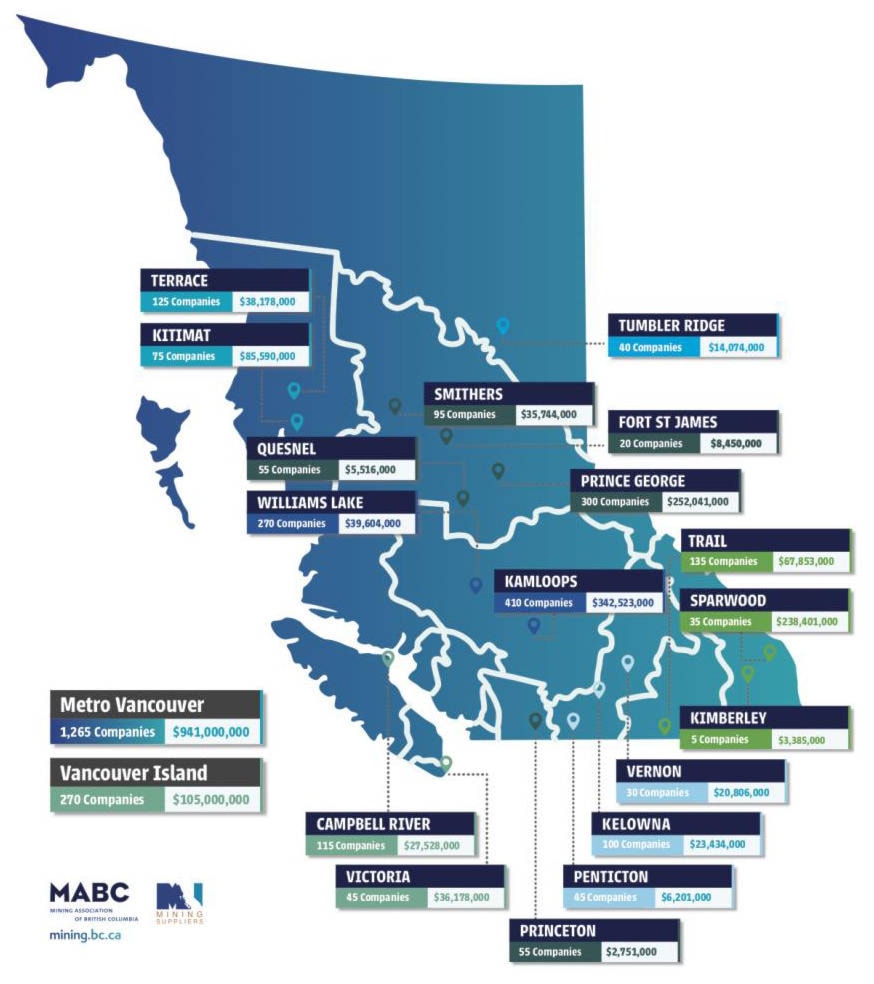Although not a mining town per se, everyone knows mining plays a significant role in the Smithers economy.
Now, the Mining Association of British Columbia (MABC) has put a number on that economic activity, and it is a big one.
According to a comprehensive report on the benefits of B.C.’s mining supply chain entitled One Province, One Economy, mining contributed nearly $36 million to the Smithers economy in 2018. There were 95 businesses in the town that directly supplied materials, goods and services to B.C. mines and smelters.
“Just about every community, every city or town in B.C. is, in some important way, a mining community,” said Michael Goehring, MABC president.
Goehring noted the data came directly from the procurement records of the province’s 17 working mines and two smelters and characterized it as “very tight and accurate.”
The Interior News was unable to find statistics on the overall size of the Smithers economy, but Mayor Taylor Bachrach said there is no question mining makes a huge contribution that affects the entire community.
And the $36 million does not represent the full economic impact of mining. It does not include the wages of residents who work directly for mining companies and their suppliers, for example.
It also does not include money spent on mineral exploration. Following the Association of Mineral Exploration (AME) Annual Roundup in January, Christine Ogryzlo, president of the Smithers Exploration Group (SEG) and a director with AME, said exploration companies spent $164 million in the Northwest in 2018. Although she could not quantify how much of that was spent in Smithers, she believed it would have been a significant percentage given the town’s position as a regional hub for the industry.
READ MORE: Good news for Smithers from mineral exploration roundup
Overall, the MABC report indicated the province’s mines and smelters purchased $2.9 billion worth of materials, goods and services from 3,700 businesses in 215 urban, rural and Indigenous communities.
“Mining this year turned a corner coming out of what was a challenging time prior to 2017, the more recent years, in terms of commodity pricing,” Goehring said.
He said going forward the issue at the forefront for his organization is sustainability.
“We’re keeping an eye on copper, the price of copper is getting low,” he explained. “I think a concern would be the global economy, the demand for commodities and how that will impact pricing.
“What’s really important in British Columbia is that we need to keep our focus on ensuring that our industry remains competitive, that’s critical. If we’re competitive, if our cost structure is competitive, we can weather commodity cycles in a greater way.”
Ensuring competitiveness and sustainability was the focus of the B.C. government’s Mining Jobs Task Force, which brought together government, industry, Indigenous communities and labour organizations. The task force generated 25 recommendations some of which the government has already implemented.
At AME roundup, for example, Premier John Horgan announced his government was making the Mining Flow-Through Share (MFTS) tax credit, and the B.C. Mining Exploration Tax Credit (METC) permanent.
He also announced $1 million each to develop a mining innovation roadmap expand the Regional Mining Alliance, which promotes mineral exploration, Indigenous partnerships and mining in B.C.
“Mining is a foundational industry and provides family-supporting jobs for communities in every corner of our province,” said Michelle Mungall, B.C.’s minister of Energy, Mines and Petroleum Resources. “Following on the recommendations of our Mining Jobs Task Force, we will continue to work with industry, Indigenous communities and labour organizations to build a strong, sustainable economy that works for everyone.”
Another element of competitiveness, said Goehring, is streamlining the environmental assessment and permitting processes, which, he added, currently take too long. “
“We’re working closely with government to ensure those new regulations, while they achieve their desired results in terms of environmental assessment process, that they don’t unduly hamper new projects or extension of existing mines,” he said.
“The Province is aware that competitiveness is and issue and is working with us to try and ensure we remain a world-class mining jurisdiction.”
Goehring also highlighted the financial impact on Indigenous communities contained in MABC report, noting the mines and smelters purchased $265 million worth of materials goods and services from 120 Indigenous-affiliated suppliers in 2018.
“The report also found that mining is a major partner with Indigenous businesses in our province and is helping to further advance economic reconciliation,” he said.
